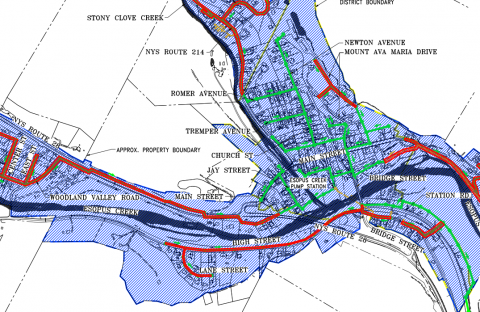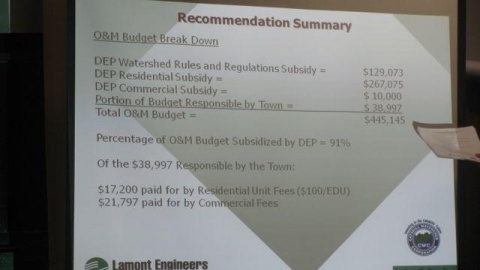
Detail of a map from Lamont Engineers showing how much of Delaware Engineering's 2007 design for the Phoenicia wastewater treatment plant they can build with existing funds. Green lines show Lamont's proposed sewer connections; red lines show connections that could be built in future if the sewer district decides to expand the plant. The original 2007 sewer district is shaded in blue. To see the complete map, see the Scribd document embedded at the bottom of this post.
The latest plan for a Phoenicia sewer system has been unveiled at last. At a cost of $15.8 million, and with 127 hookups serving 194 businesses and households, the system is smaller -- and cheaper -- than the proposed system that was rejected by voters in 2007. Whether that will convince skeptical residents of the hamlet to give the plan the green light remains to be seen.
On Thursday, October 20, the Town Board of Shandaken held a special public meeting with the Catskill Watershed Corporation (CWC) and Lamont Engineers, the firm contracted by the CWC to design the system now on the table.
As required by the 1997 watershed agreement between New York City and watershed towns, the New York City Department of Environmental Protection (DEP) has set aside a $17.2 million block grant for the construction of a sewer in Phoenicia. But in 2007, the hamlet voted down a proposed $17 million system designed by Delaware Engineering that would have served a larger area than the current proposed system. To build that system today, Lamont estimates, would cost over $24 million.
So far, CWC attorney Tim Cox says, the town has spent about $1.4 million of the original block grant on designing and permitting the system that was voted down in 2007, and on the study of alternative plans. Lamont's task was to design a system that would work within the remaining $15.8 million.
The current system is designed so that additional hookups can be added in future, if the sewer district is expanded.
 Comparison of sewer plans rejected in 2007 with current plans. From CWC data.
Comparison of sewer plans rejected in 2007 with current plans. From CWC data.
The joint recommendation from Lamont and the CWC is for a membrane bioreactor wastewater treatment plant. The proposed plant would have a capacity for 130,000 gallons of water per day, with 127 connections built to within 5 feet of the hooked-up buildings. The costs of hooking up buildings to the system would be paid for by the block grant.
 Julie Barown of Lamont Engineers presents the report summary while members of the town board listen attentively with 18 inches of engineering report to be read sitting in front of each of them.
Julie Barown of Lamont Engineers presents the report summary while members of the town board listen attentively with 18 inches of engineering report to be read sitting in front of each of them.
Businesses and homeowners will have the option of receiving a variance from the requirement to connect to the public sewer if they can show that they have a functioning septic system, Lamont engineers said.
Many of the lots in Phoenicia are too small to meet the DEP's current standards for septic systems, even if their systems are not currently failing. Only 15 percent of the lots in the proposed sewer district can accommodate a system that meets present-day DEP standards, said Julie Barown, P.E., who presented the details of the proposal on behalf of Lamont Engineers.
The construction cost of the membrane biologic system is projected to be $6.7 million, with the cost of the wastewater collection system an additional $5.9 million, for a total construction cost of $12.6 million. Added to this amount would be $3.2 million for administrative, legal, SEQRA Compliance, permitting, engineering (design and construction), easement acquisition, etc.
The total project cost is set at $15.8 million. This amount will be totally paid for from the existing block grant from the DEP.
The proposed plant would have a capacity of 130,000 gallons per day, while Lamont Engineers expects that realistically the flow will be from 50 to 80,000 gallons per day.
The DEP would pay for 91.2% of the projected $445,145.00 annual operating and maintenance costs of the sewer system. The new sewer district would be responsible for only $38,997 (8.8%) of the total, broken down as $17,200.00 (44%) paid by residences, and $21,797.00 (56%) paid by businesses.
 Lamont Engineers’ slide showing the Operation and Maintenance budget breakdown.
Lamont Engineers’ slide showing the Operation and Maintenance budget breakdown.
Pursuant to the 1997 watershed agreement, the residential fees would be capped at $100 per year for the first three years regardless of how many residences or businesses hooked onto the system.
Alfie Higley, currently a candidate for the Town Board, asked if there was a cap on business contributions. Supervisor Rob Stanley responded that negotiations were ongoing at this point, but that he hoped something could be done.
A map was shown which showed the sewer district voted down by public referendum in 2007 in blue. The green areas on the map show where the 127 connection points would be located in the current proposal, with the red areas showing possible expansion in the future. The proposed treatment plant is capable of handling waste from both green and red areas, according to Lamont Engineers.
“The proposal is a full size plant, but only the core of the collection system,” said Barown.
“What is the time frame on this?” one local resident asked.
Stanley replied: “It has go to the DEP, the DEP may have to vet it out for review, and then the DEP comes back to the town and either approves or denies this recommended system. At that point the CWC goes into a design phase to further solidify the numbers, and then it will go to a public referendum.”
Kathy Nolan, currently a candidate for Town Supervisor, asked if there was not an even cheaper option which would involve individual septic systems with their waste passing through biological pre-treatment from a bio filter, with the filtered wastewater collected for processing in a smaller town system. The response from Lamont Engineers was that based on other communities with that type of system, DEC regulations would require a 40-acre drainage field out of the flood plain no matter what alternative systems might be used, in order to discharge the flow from Phoenicia.
 A local resident who told the town board that the sewer system is only one part of the more fundamental issue of bridges and stream management in Phoenicia.
A local resident who told the town board that the sewer system is only one part of the more fundamental issue of bridges and stream management in Phoenicia.
A resident of Phoenicia asked, “Where does this sewer plan fit into the overall picture of Phoenicia flooding? The DEC controls a big piece of the flooding problem with the portal [the Shandaken Tunnel, which carries water from the Schoharie Reservoir into the Esopus above Phoenicia]. The DEC doesn't even know we are here. How are they held responsible for damages, because they are part of the problem. I know the DEC is responsible for a couple of thousand dollars' damage to me this year. The portal and bridge are a big part of the issue, you can't separate the issues.”
“The portal was shut down during the flood,” replied Stanley. “The DEP says the bridge must be redesigned, we are still waiting for Ulster County on this.”
The issue of flooding related to streams and bridges is not addressed by the available DEP block grant for the Phoenicia sewer system. Lamont and CWC representatives said that it was a separate issue.
Barown told the Watershed Post in a later interview that during a flood, the flow would increase to the proposed plant, but that the designed system uses flood-resistant manhole covers so that no water enters through them. The only flood water that gets into the system comes through connected houses.
“Out of 12 flooded sewer systems during Irene, only three or four were not online completely three days after the flood,” she said.
This article was revised on Tuesday, October 25 to correct several errors. The number of commercial buildings in the 2007 proposal was 29, not 20, and the total number of users 373, not 375; the cost of the currently proposed collection system is estimated at $5.9 million, not $5.7 million; and we clarified the wording of several points on the recommendation of Julie Barown, a Lamont engineer.
Below: A PDF of the map of the proposed sewer system. Green lines show proposed sewer connections; red lines show connections that could be built in future if the sewer district decides to expand the plant. The original 2007 sewer district is shaded in blue. Use the buttons in the embedded window to zoom in for greater detail.
2011 Proposed Design for Phoenicia Sewer System (From Lamont Engineers)













